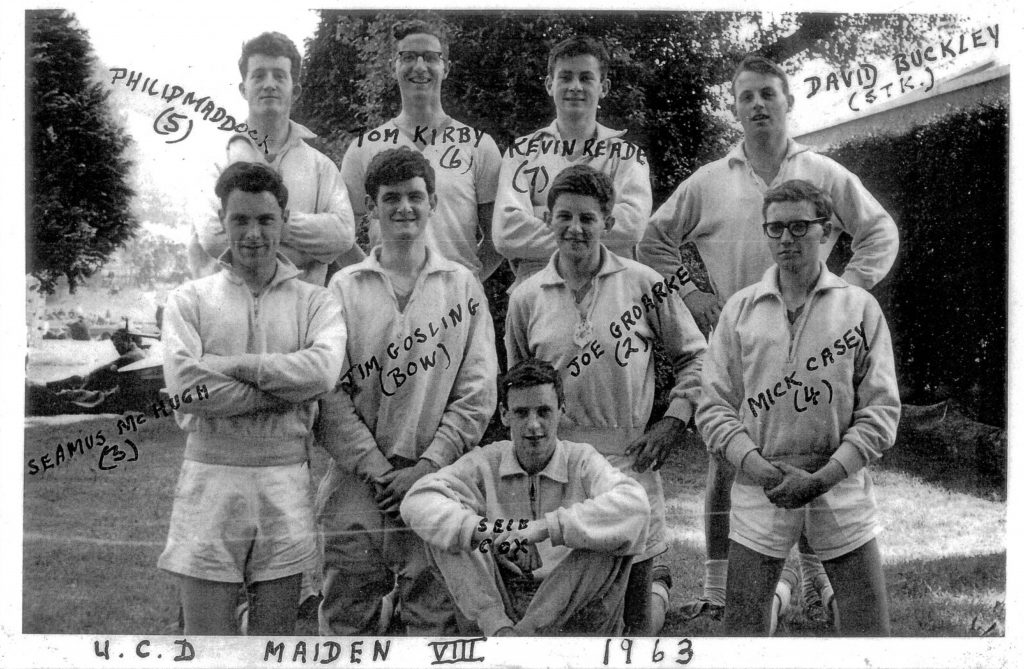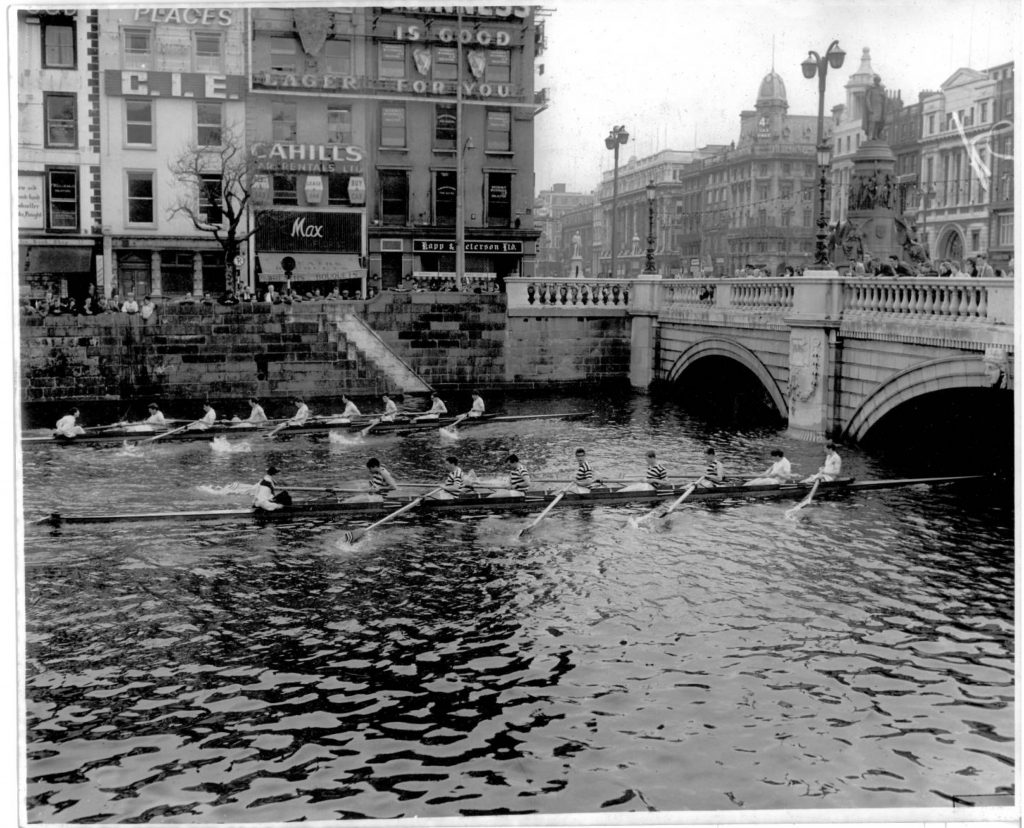In 1962 College did not open until October. A quick few sorties in the BOX and the tub pair had one ready for the wide wooden IV borrowed from Trinity. It was a beautiful pre-war boat wooden clinker with brass fittings. It was flat bottomed and the seats were offset from the centre . It was before the era of the five day week and lectures were from 9am -1pm on a Saturday morning. Practice at 2.30 on Saturday and Sunday afternoons did not furnish much time and prevented any dawdling. Austin Carty was a great Captain and organiser. Everybody got out in an VIII. By December he had four VIIIs that he took to Belfast for a Queen’s at home. On the way back the bus was in full voice singing “Kevin Barry” and the “Boys of Kilmichael” when we were stopped at the border by the “B” specials. John had a terrific task in trying to silence us. We were a lively lot with John Dowling being one of the liveliest. The Boat Club Balls were a huge College Event in those days and the 1962 Boat Club Ball had more than 500 at it.
College was tiny in those days crammed into Earlsfort Terrace . Just inside the entrance between the main door and the Porter’s lodge was the Boat Club Notice Board. It had a radiator underneath and a great meeting place for maidens. The head porter , Paddy Keogh, got to know us very well and tolerated our horse play. In Hilary term one had to check whether one was selected for the “Flippers”, “Flappers” or “Floppers”. On occasion one would see the late Seamus O’Scollain complete with his 7’ Boat Club Scarf strolling along the corridors as his class emerged from one of Jim Meenan’s. lectures. Seamus was an unsung hero in that he ensured that Ireland had large Petroleum reserves during a period the country would have been closed down without them. Austin made sure that the Maidens got many away trips including the Galway head and the Erne Head (for which Saturday lectures had to be missed). The Galway head was particularly traumatic as we had to be pulled out of a dance in Salthill before being attacked by a local crowd. We did not get out as early as was necessary as a few stragglers had to be rounded up and the bus was surrounded and terrorised for about 5 minutes.
Trinity Regatta that year was on the June Bank Holiday and our first regatta. The maidens came nowhere. A little later we travelled to Cork for three regattas, Cappoquin, Cork and Fermoy and came away with five trophies. The IV had replaced Phil Maddock who was as strong as an OX by the late Seamus McHugh from the Glenties. Seamus who had trained as a primary school teacher and not at the age of 27 was taking a degree to become a secondary school teacher transformed the crew from Novice to Senior he had such a steadying mature influence. From then on it was virtually unbeatable. It led by so much in Carlow that that we easied lengths before the finishing line and glided to victory to the music of a brass band.
Another member of the crew, Jim Gosling, influenced the shape of Dublin. He lived in an attic flat in Merrion Square and wrote continuously to the Irish Times objecting to the proposal to build a Cathedral in Merrion Square. It had been a running sore that the Church of Ireland had commandeered Dublin’s only two Cathedrals and the RC’s had only been left with a pro-Cathedral. To build a Cathedral was as imperative as making up for losing the battle of Kinsale. Jim’s task seem impossible but he persevered and won.
This year was a momentous year in the history of Ireland and the World. It was a period of intense political, social and economic change. It saw the first Bond film, Dr. No, shown in No. 85 St. Stephen’s Green. It was the era of Hatch Hall, Loreto Hall and Dominican Hall now all gone. I have just seen the “Sold” sign on Loreto hall. It was the era of the Ouzel Galley that one walked through to get the 25, 26, 66 or 67 on Ashton Quay to the Boat Club. If one was short one had to get off the bus at Booth Poole (4d) as the Boat Club was 6d. It was a great caring warm friendly club with Billy Bass repairing boats and blades with his shoe polish tin of glue sitting on his Bunsen burner, regaling us with the stories of great crews in particular the crew of 1932 that came second in the Chester Head. In lectures one dreamt of the outings to come, the splash of water at the catch and the movement of the boat. One could hear the cry of the seagulls hovering over the Corporation rubbish dumps not far from the banks. It takes a while for the happy memories to seep back. It would be nice to see many of that year again at the Centenary.
The photo above appeared in the Irish Independent on the Monday after the Dublin Head. In 1963 there was no Junior VIII as the previous year’s Maidens had all left. We started in fourth position just in front of Trinity’s Junior VIII and they finally caught us approaching O’Connell Bridge. On the road O’Connell Bridge is as wide as it is long leaving very long narrow arches on the river. I had positioned myself in the centre of the river with a dead straight course through the centre arch which is not much wider than an eight and oars. Trinity came on my outside and headed for the same arch. Two into one does not go and I was forced to swing out to my left for the wall and hope I could straighten and get an approach for the arch. It was my first time on the lower Liffey and I was terrified. We got through without a scratch. The second photo was taken on the front lawn of the old UCD Boat House.
Jim Heney


zka6u8
9ucd75
vy056v
rviurj
l664wp